Swimming Technique Concepts: Maximizing Velocity For Backstroke, Breaststroke
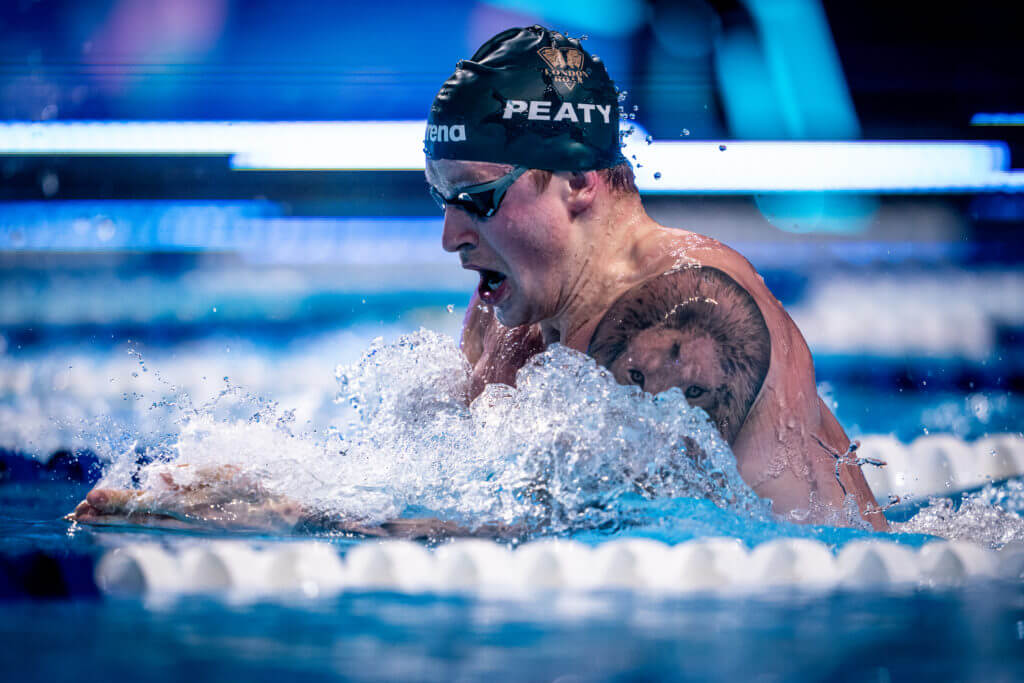
Swimming Technique Concepts: Maximizing Velocity For Backstroke, Breaststroke
By Rod Havriluk, Ph.D.
Previous articles in this swimming technique series presented data about the stroke cycle component times for the arms of elite male sprinters for all four strokes. The data showed that swimmers do not always take full advantage of the time that they could generate propulsion so that the average propulsive phase times could be slightly longer. The data also showed that swimmers waste considerable time so that the average non-propulsive phase times could be shorter.
A swimmer who has a sufficient propulsive phase and who eliminates wasted time on the non-propulsive phase can optimize stroke cycle time. This article presents optimal times for both the propulsive and non-propulsive phases of backstroke and breaststroke, and predicts corresponding performance improvements.
PROPULSIVE AND NON-PROPULSIVE PHASES
In backstroke, the propulsive phase is the combination of the pull and push phases. In breaststroke, propulsive phase is the combination of the outward and inward sculling phases. In backstroke, the non-propulsive phase combines the recovery and entry phases. In breaststroke, the non-propulsive phase combines the recovery phase and the glide phase.
Backstroke propulsive phase = pull + push phases
Breaststroke propulsive phase = outward + inward sculling phases
Backstroke non-propulsive phase = recovery phase + entry phases
Breaststroke non-propulsive phase = recovery phase + glide phase
The striped bars in the graph in Fig. 1 shows the average propulsive and non-propulsive phase times at sprint pace for elite male swimmers for backstroke and breaststroke (Chollet, Seifert, Carter, 2008; Leblanc, Seifert, Baudry & Chollet, 2005).
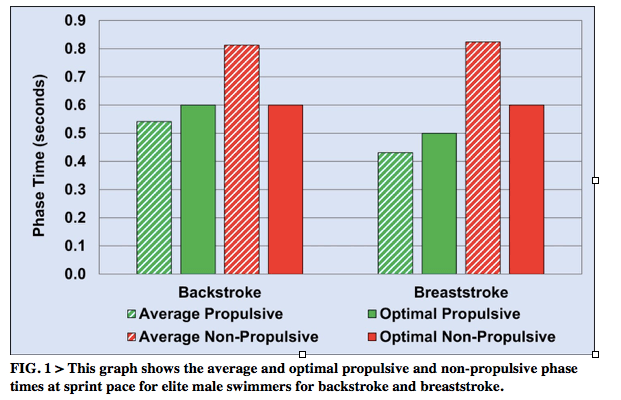
BACKSTROKE AND BREASTSTROKE AVERAGE PROPULSIVE PHASE TIME
The average propulsive phase time for backstroke is very similar to the average propulsive phase time for butterfly and freestyle. These three strokes are similar in that the propulsive phase is the combination of the pull and push phases. The average propulsive phase time for breaststroke is slightly less than for the other three strokes, but unlike the other three strokes, the arms stay in front of the shoulders for a smaller range of motion that requires less time.
BACKSTROKE AND BREASTSTROKE OPTIMAL PROPULSIVE PHASE TIME
Achieving an optimal propulsive phase time requires taking full advantage of the propulsive phase. The optimal propulsive phase time for both strokes is slightly longer than the average propulsive phase time to ensure a swimmer will have adequate time to generate propulsion. The solid green bars in the graph in Fig. 1 show the optimal times for the propulsive phase for backstroke and breaststroke. The optimal propulsive phase is shown for backstroke in Fig. 2 (top image) and for breaststroke in Fig. 3 (top image).
SWIMMING BACKSTROKE AVERAGE NON-PROPULSIVE PHASE
The average non-propulsive phase time in backstroke is longer than the average non-propulsive phase time in freestyle or butterfly for two main reasons:
1. Swimmers must change the vertical direction of the arm from downward to upward, and
2. Swimmers must exert considerable effort to move a straight arm to the surface. The result is an unavoidably longer recovery time for backstroke than for butterfly or freestyle.
BACKSTROKE OPTIMAL NON-PROPULSIVE PHASE
Most swimmers can decrease the non-propulsive phase to 6-tenths of a second by completing the propulsive phase with the hand next to the hip and then quickly moving the thumb edge of the hand upward, as shown by the model in Fig. 2 (bottom image).
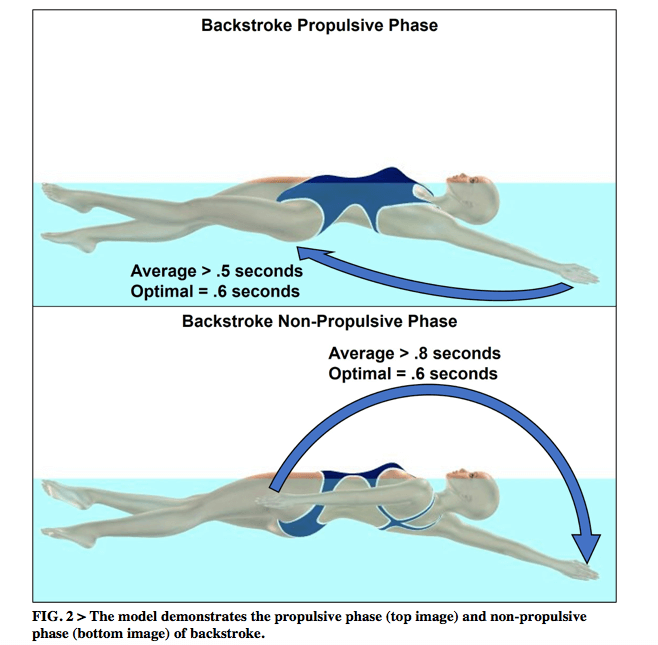
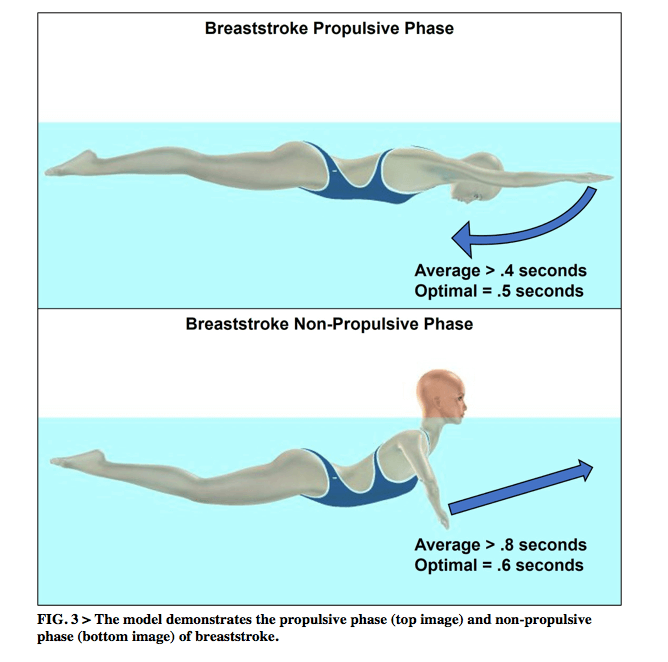
SWIMMING BREASTSTROKE AVERAGE NON-PROPULSIVE PHASE
The average breaststroke non-propulsive phase is over 8-tenths of a second and is too long because of:
1. An above-surface hand recovery, and
2. An excessively long glide.
BREASTSTROKE OPTIMAL NON-PROPULSIVE PHASE
To minimize the time spent in the non-propulsive phase, a swimmer must recover the arms below the surface to achieve a streamline position as quickly as possible. In addition, the outward sculling motion must begin as soon as the arm recovery is complete. With this coordination, the glide phase would require no time, and a swimmer could achieve an optimal non-propulsive phase time, as shown by the model in Fig. 3 (bottom image).
PERFORMANCE IMPROVEMENT FROM DECREASING NON-PROPULSIVE PHASE TIME
The optimal phase times allow for the calculation of a predicted performance improvement by using the drag equation. The drag equation shows that swimming velocity is proportional to the average propulsive force per stroke cycle time for any given group of swimmers. The average propulsive force was calculated for the two studies listed by substituting the average swimming velocity and stroke cycle times. The drag equation was used again to calculate an optimal swimming velocity by substituting the average propulsive force and the optimal stroke cycle phase time.
The average and optimal stroke cycle times and swimming velocities for the elite backstrokers and breaststrokers are listed in Table 1 (below), as well as the potential performance improvement. Decreasing the non-propulsive phase time would also decrease the stroke cycle time, increase the average propulsive force per stroke cycle and improve the performance of the swimmers in these studies above to approximately world record times.
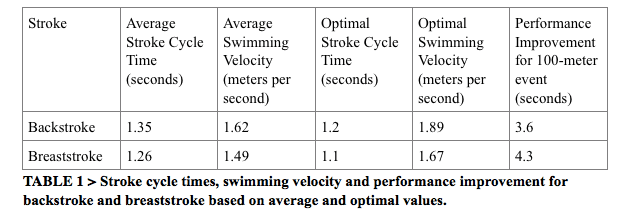
SWIMMING TECHNIQUES SUMMARY
There is the potential for considerable performance improvement in backstroke and breaststroke primarily by decreasing the non-propulsive phase time. Calculations using the drag equation predict that even the elite swimmers from the studies in Fig. 1 can make substantial performance improvements and achieve world record times.
Dr. Rod Havriluk is a sport scientist and consultant who specializes in swimming technique instruction and analysis. His newest ebooks in the “Approaching Perfect Swimming” series are “Optimal Stroke Technique” and “Swimming Without Pain,” and are available at swimmingtechnology.com. Contact Rod through info@swimmingtechnology.com.



